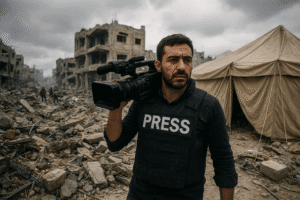The Unseen War: The Journalists of Gaza Reporting from the Edge of Survival
In Gaza, journalists are reporting from a world of devastation while living inside it. Their offices are tents pitched near hospitals—the only places with power and internet—yet these locations offer no safety from strikes. They work under the constant fear of being targeted, with nearly 200 colleagues already killed. Beyond the imminent danger, they endure the same famine and displacement they document, often working through severe hunger and exhaustion. The psychological toll is profound, numbing their emotions and forever altering their minds. Despite this, they persist, driven by a duty to ensure the world sees the truth, making their work one of both profound sacrifice and defiant witness.

The Unseen War: The Journalists of Gaza Reporting from the Edge of Survival
We often see the news from Gaza: the blur of rubble, the statistics of the lost, the raw footage of grief. But we rarely see the people behind the camera, the ones who bear witness so the world cannot look away. Theirs is a story not just of reporting on a catastrophe, but of living inside it.
A Newsroom Without Walls
Imagine your office is a tent. It offers no protection from the searing summer heat, turning it into a suffocating greenhouse. It provides no warmth against the winter chill, leaving you shivering in a makeshift refrigerator. There is no running water, no bathroom, no quiet corner to think.
This is the reality for Abdullah Miqdad and most journalists in Gaza. After 22 months of war, the traditional newsroom is a memory. Their new base of operations is often the perimeter of a hospital. The reason is tragically simple: hospitals are among the last places with functioning generators, offering the two lifelines they need to work—electricity and an internet connection.
But this choice comes at a horrific cost. Positioning themselves near these critical facilities has not granted them safety. It has made them targets.
The Constant Shadow of Fear
The numbers are staggering. According to the Committee to Protect Journalists, at least 197 journalists and media workers have been killed since the war began. The overwhelming majority are Palestinians killed in Gaza.
This is not a abstract statistic for those on the ground. It is a daily, grinding terror.
“As journalists, we feel we are targeted all the time,” says Ahed Farwana of the Palestinian Journalists Syndicate. This pervasive fear is a dual burden: the fear for their own lives, and the paralysing fear for the families they are trying to protect and provide for.
The recent double strike on Nasser hospital, which killed five journalists, underscores this brutal reality. One moment, Reuters cameraman Husam al-Masri was doing his job. Minutes later, a second strike killed his colleagues who had rushed to the scene. While Israeli Prime Minister Benjamin Netanyahu called it a “tragic mishap,” for those left behind, it feels like a pattern.
The Human Behind the Lens
The professional challenges are immense. A new, raw generation of reporters—many with no prior experience—has emerged out of necessity. They work on fleeting contracts, often without the protective gear, insurance, or support their international counterparts rely on.
But it is the personal toll that truly defines their existence.
Their struggle is no longer just about getting the story; it’s about basic human survival. A UN-backed body has confirmed famine in Gaza City. The journalists reporting on this hunger are living it.
“A cup of coffee mixed with ground chickpeas, or a glass of unsweetened tea, might be all you can consume during an entire workday,” describes independent journalist Ahmed Jalal. “We suffer from severe headaches and fatigue, unable to walk from the sheer hunger… but we still carry on with our work.”
Ahmed speaks of a heart breaking from the pain of reporting on a colleague’s death, while his mind whispers, “I might be next.” The pain is consumed internally, hidden from the camera’s unblinking eye.
The Numbing of the Soul
Perhaps the most profound insight comes from Ghada al-Kurd, a correspondent for Der Spiegel. She speaks of a psychological shift that has taken place over these two long years.
“During this war, we have lost the ability to express our emotions,” she says. “We are in a constant state of shock.”
She holds her fear for her daughters and her grief for her brother’s family, lost under the rubble, in a suspended state. The work requires a numbness to function, a necessary detachment from the very horrors they are documenting. The war, she knows, has changed their psyches irrevocably. The healing will require a lifetime.
Why Their Story Matters
The journalists of Gaza are more than just reporters; they are the essential thread connecting a humanitarian disaster to the world’s conscience. They work not for glory or awards, but from a profound sense of duty—to document, to testify, to ensure that the stories of their people are not erased.
They do so while exhausted, hungry, displaced, and grieving. They stand in front of the camera, as Abdullah Miqdad says, having to be “highly focused, mentally alert, and quick-witted despite the exhaustion,” all while calculating the escape route from their own potential execution.
Their commitment, under conditions unimaginable to most of us, is a powerful testament to the human spirit. It reminds us that even in the face of utter devastation, the drive to bear witness, to speak truth, and to be seen, remains one of our most powerful and defiant acts.
You must be logged in to post a comment.